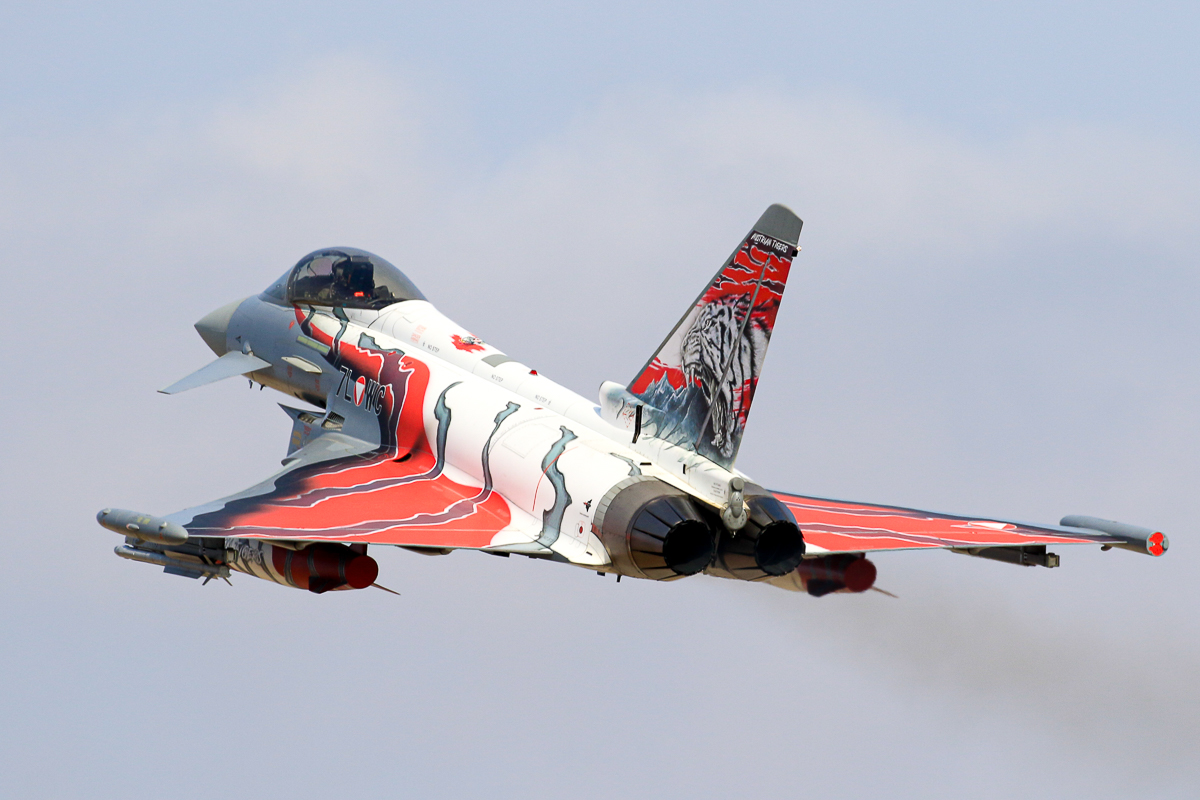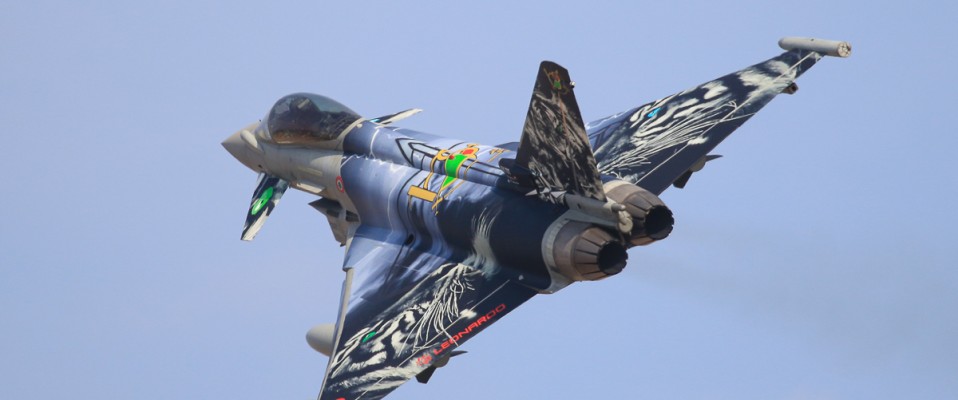NATO Tiger Meet 2023
Report and photos by Gabriele Rivera
December 15, 2023
The Tiger Meet is a really unique exercise; its origin traces back to the 1960, when the pilots of the 79th Fighter Squadron, USAFE, temporarily deployed at RAF Woodbridge (UK) with their North American F-100D Super Sabre, and those of the 74th Squadron, RAF, whose English Electric Lightning were based in Coltishall (UK), decided to meet at Woodbridge to spend some time together chatting with a glass of whisky in their hands. The year after this meeting saw the addition of the French pilots of the Escadron de chasse 1/12 Cambrésis, flying with Dassault Super Mystere B2.
All three of the squadrons had a tiger as their insignia, so USAFE Lt. Mike Dugan thought to invite all the NATO squadrons with similar badges; several units replied positively to the idea, starting an administrative process that brought NATO HQ to approve definitively the Tiger Meet (usually referred to as NTM). This process transformed the original social gathering, held for the first time at Woodbridge in August 1962, in a chance to train together and pursue close professional relationships, and so the NATO Tiger Association was created in order to organize the yearly occurrences of this exercise.

The first Air Forces to “subscribe” their Tiger units to the NTA were those of USA, UK, France, Belgium, Canada and Germany; nowadays the countries being part of NTA are 12, while the squadrons are 24. These numbers tend to change during the years, especially because some units are disbanded due to their Air Forces’ restructuring processes, and other are reinstated after years of disbandment, often moving from airplanes to helicopters.
In 2023, after 35 years, the exercise has been staged again in Italy, a welcome coincidence with the ItAF’s 100th anniversary (but not a planned one, because the schedule is decided several years in advance). Despite the goliardic origins, managing a TM exercise is trickier than an average one; out of 24 actual member units, 16 have taken part to this 59th edition (plus 1 as observer) and, as one can easily imagine, managing roughly 80 planes and helicopters and 1,300 men and women on a single base is not an easy task. But the host unit, the 36th Stormo (Fighter Wing), based at Gioia del Colle, Puglia, has successfully managed and won this challenge; collaborating with the civilian Air Traffic authorities, the DIREX (Director of Exercise), an ItAF Colonel, and his team, have launched along nine days over 800 sorties, exceeding 1,200 flight hours.

The sorties have taken place over an area comprising nearby regions (Calabria, Basilicata) and ample zones of airspace over the Tirreno and Ionio seas; this is already a huge training return for those participating units which don’t have regular access to wide airspace areas free of civilian traffic (like some northern Europe countries, for instance). Each day’s activity has been divided in two waves; the main one in the morning, a COMAO (COMposite Air Operation), and a shadow wave in the afternoon.
The COMAO is an LFE (Large Force Employment) training opportunity, involving all the assets in a complex operation. The forces are traditionally divided in Red and Blue parties; the Reds are entirely managed by the DIREX, seeking to enforce the right degree of complexity to the Blue forces (also because there is a prize to win, the Silver Tiger Trophy, for the unit which performs the operations at best, this edition assigned to the TaktLwG 74). The shadow waves comprehend complementary missions, like Basic Fighter Manoeuvring and Air Combat Manoeuvring, Electronic Warfare, Slow Mover Interception, Close Air Support and Personnel Recovery. The sorties must of course include training activities for the helicopters squadrons, which, during the years, have phased out their fighters and after periods of disbandment have been brought back in service with rotary wing machines.

Thanks to the large number of assets taking part to the TMs, the training can be performed on a multi-domain level. The host country must put at disposal the needed resources; this edition has so included the participation of a Marina Militare’s (Italian Navy) vessel, the destroyer Caio Duilio, and two JTAC (Joint Terminal Attack Controller), provided by the Brigata Marina San Marco (Italian Navy Amphibious Brigade). The ItAF 2nd Stormo has deployed also a the SIRIUS battery, a GBAD (Ground-Based Air Defense) asset, the 16th and 17th Stormo have respectively brought in the action the Fucilieri dell’Aria e gli Incursori (Air Fusiliers and Raiders), the 202nd Gruppo has brought a SIAI Marchetti U-208A (exhibiting a fantastic celebratory colour scheme), the 46th Brigata Aerea (Air Brigade) has contributed with a Lockheed C-130J Hercules, while the 14th Stormo has managed the air refuelling operations, performed by a Boeing KC-767, and heavily contributed to the AEW-BM&C (Airborne Early Warning, Battlefield Management & Communication) missions with a Gulfstream G550 CAEW (an especially valued asset).

All these contributions have allowed the DIREX to increase the level of complexity of this Tiger Meet, configuring some COMAOs as ASuW (Anti_Surface Warfare) or SEAD (Suppression of Enemy Air Defence) missions. To ensure the likelihood to a real contested environment, a Boeing E-3A Sentry (AEW&C Flying Squadron 1, a TM full member since 1996), deployed to FOB (Forward Operating Base) Trapani Birgi, has joined the operations together with the aforementioned ItAF G550 and two Grumman E-2C Hawkeye (Marine National, the French Navy), based at Gioia del Colle, despite not being a Tiger unit. Another addition to the ethereal world of electronic warfare is a regular guest of almost any NATO exercises, a Learjet 35A operated by GFD, an AIRBUS company, which, using her Threat Simulator Pod, broadcasts the signatures of existing radars, providing a near-perfect simulation of approaching aircraft or guided missiles and creates false targets for the participating aircraft.

But now let’s talk about the unique spirit that permeate this yearly exercise; the participating units are more or less the same year after year, so very strong ties develop among pilots and crews that meet and train together with such regularity. Each unit is encouraged to deploy, when available, a two-seat ship, in order to give a flying tour to other units’ colleagues. During the opening ceremony the host base Commander makes a short welcoming speech, after that a visiting General give the official start with a sentence borrowed from the Olympics: “I declare the 2023 NATO Tiger Meet open!”, and then host squadron commander dismisses the participants with the “Tiger, Tiger, Tiger” call.
Then there’s the International Night: each squadron shows off the foods, drinks, music, and dress typical of their country. Not to mention the Tiger Games; a competition where the crews must challenge each other performing games that require the most different skills. The lucky ones who have had the chance to attend to these events bring back stories which are challenging to believe.
Other typical features are the customised flight suits and work uniforms worn by pilots and crews; tiger scarves are the most common, but imagination rules supreme to find new themed garments at each edition (also because there is a price for the best uniforms, this year won hands down by the Turkish with their blazing red suits).

But the stars of this tiger circus are the airplanes themselves; most units go to great lengths to bring to the exercise one special colour or, at least, a special tail; needless to say the leitmotiv is always tiger-related (truth to be told, there are also pumas, jaguars and leopards). When operational reasons or other considerations force some squadron to deploy their aircraft with only minimal reference to the feline theme, they often find a quantum of solace painting the wing tanks.

This edition has seen a fierce competition among the three Typhoon squadrons (the German one resulting the winner), but several special tails have been deeply appreciated; the French have brought a Rafale and a Mirage with a sort of tiger medallion, painted silver on the left side and golden on the right one, while the robot tiger depicted on the tail of a Czech Gripen has impressed many. Another brilliant work has been made on two Turkish F-16, while the Greek “Mafia” tiger will be long remembered. A special mention must be made for the French Gazelle, entirely painted in two tones of red, sporting a “Scuderia dei felini” (Feline team) marking and the unit number painted black on a white roundel that immediately has been associated to the Formula 1 world.
In 2024 the exercise will be held in Schleswig, Germany, hosted by Taktisches Luftwaffen Geschwader 51. See you there!
Participating units:
Austrian Air Force 2.Staffel Zeltweg AB EF-2000 Eurofighter
Belgian Air Force 31 Smd Kleine Brogel AB F-16A/B MLU Fighting Falcon
Czech Air Force 211 TL Čáslav AB JAS-39C/D Gripen
French Air Force ECE 1/30 BA 118 Mont-de-Marsan Mirage 2000D and Rafale B/C
French Army Aviation EHRA 3 BA Etain-Rouvres EC-665 Tigre HAP and SA-342M Gazelle
Italian Air Force 12° Gruppo Gioia Del Colle AB EF-2000 Eurofighter
21° Gruppo Grazzanise AB HH.101 Caesar
German Air Force TaktLwG 51 Schleswig AB Tornado IDS & ECR
TaktLwG 74 Neuburg AB EF-2000 Eurofighter
Hellenic Air Force 335 Mira Araxos AB F-16C/D Fighting Falcon
Hungarian Air Force 101/1 Sqn Kecskemét AB JAS-39C/D Gripen
NATO 1 AEW&C Geilenkirchen MOB E-3A Sentry
Polish Air Force 6 ELT Poznań-Krzesiny AB F-16C/D Fighting Falcon
Portuguese Air Force Esq 301 BA5 Monte Real F-16A/B MLU Fighting Falcon
Swiss Air Force Staffel 11 Meiringen AB F/A-18C/D Hornet
Turkish Air Force 192 Filo Balikesir AB F-16C/D Fighting Falcon
Gabriele was born in Turin, Italy, grew up in Sicily and now lives in Rome. His love for aviation goes back to the days when he was seven years old, he started to collect the ‘History of Aviation’ sold weekly at the nearby newsstand. With that, he realized that his goal was to become a military pilot. This dream met a harsh reality when, during the medical tests, a defect in his chromatic sense of sight was discovered.
His interest in photography arose a few years later, when he bought from a colleague his first single-lens reflex camera, a Pentax ME Super. Then everyday life took its toll; working as an IT analyst, studying for an MD in political science and starting a family left no time for enjoying his old interest for aviation. One day in 2008, he decided to revive the passion, starting again to take pictures of aircraft each time he has a chance. Now, using Canon gear, he is striving to become a photojournalist.
Gabriele can be reached at: [email protected]

